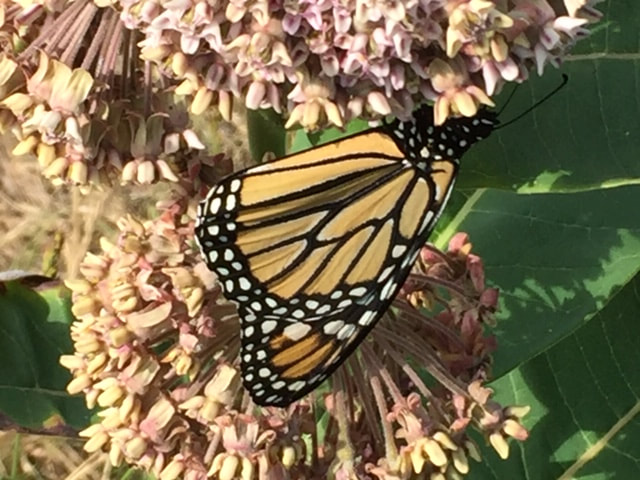|
In late May a friend of mine in Abiquiu told me that he saw at least 10 Monarch butterflies clustered together in one group, a sighting that warmed my heart because the year before I had seen so few.
Last year I was fortunate enough to have a milkweed plant seed itself by the casita. When the seeds ripened in the fall I scattered the silky airborne parachutes under the original plant hoping that the milkweed would re –seed. This spring I was rewarded. Three new plants emerged in a place that would be watered as long as we had summer rains. When I left Abiquiu the plants were doing well, but summer would tell the tale… Milkweed is the one plant that Monarchs love and the only plant on which they will lay their eggs. I hoped that a small cluster of these plants might provide sweet nectar that would entice a few more of these butterflies to visit the casita during the summer and during fall migration. It should be mentioned that milkweed also provides an intriguing form of protection for this butterfly. The milkweed juices make the Monarch poisonous to predatory birds. Additionally, the deep orange color of the butterfly alerts predators to the fact that their intended meal might be toxic. Here in Maine I have a field that is covered in milkweed from early July onward. I have raised many Monarchs to adulthood over a period of thirty years because it has been relatively easy to find the eggs which are laid on the underside of the milkweed leaves beginning in late summer. The scent of the flower is, to me, intoxicating, and the clusters of tiny blossoms are so beautiful to look at in their myriad shades of pale pink salmon. Ever since the milkweed started blooming this summer I have been on the lookout for Monarchs. I saw my first butterfly at Popham beach on the coast where Milkweed plants are plentiful growing amidst the sand dunes, and in wild coastal fields. I then glimpsed two around my house this week, and remain hopeful that I will see more… Monarch butterflies are perhaps best known for their migrating habits. No other butterflies migrate as far; this insect flies up to three thousand miles each year. Millions of these butterflies will fly from Canada to Mexico this fall. (Oddly though, populations in Florida apparetnly don’t travel). More astonishing this entire trip will take four generations to complete. The Monarchs begin their southern migration September to October. Eastern and northeastern populations, originating in southern Canada and the United States, travel to overwintering sites in central Mexico. They arrive at their roosting sites in November. When the butterflies reach their destination in Mexico they return to the same trees that their forbearers did sometimes roosting deep in the forest. They remain in their roosts during the winter months and then begin their northern migration in March. No individual butterfly completes the entire round trip. Female monarchs lay eggs for a subsequent generation during the northward migration. Four generations are involved in the annual cycle. Western populations, which would include the Monarchs in New Mexico, follow a similar pattern migrating annually from regions west of the Rocky Mountains to overwintering sites on the coast of California. Many folks know that the Monarch butterfly population has dropped 90 percent over the past 20 years (Center for Biological Diversity). The species has become ‘functionally extinct’, meaning that the numbers are so low now that the Monarchs have little hope of long-term survival. Scientists look to monarchs and other butterflies as indicators of environmental health, since they are easily affected by air and water pollution, severe weather, pesticides, the presence of other toxins and, of course, Climate Change. It breaks my heart to acknowledge that most folks have not paid attention to the decline of these beautiful insects. Globally we are paying a huge price for our blindness and indifference. When it comes to Monarchs the present is what we have, and I encourage anyone that gardens to create a milkweed patch for these wanderers in the hopes that we might extend their collective lifetime a few more years. It’s important to note that milkweed needs adequate water. Refusing to use lethal backyard pesticides and planting milkweed are two things we can do to help these glorious orange insects thrive in the short term.
0 Comments
Your comment will be posted after it is approved.
Leave a Reply. |
Submit your ideas for local feature articles
Profiles Gardening Recipes Observations Birding Essays Hiking AuthorsYou! Archives
October 2025
Categories
All
|

 RSS Feed
RSS Feed